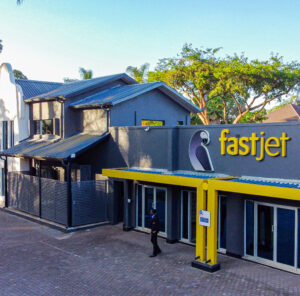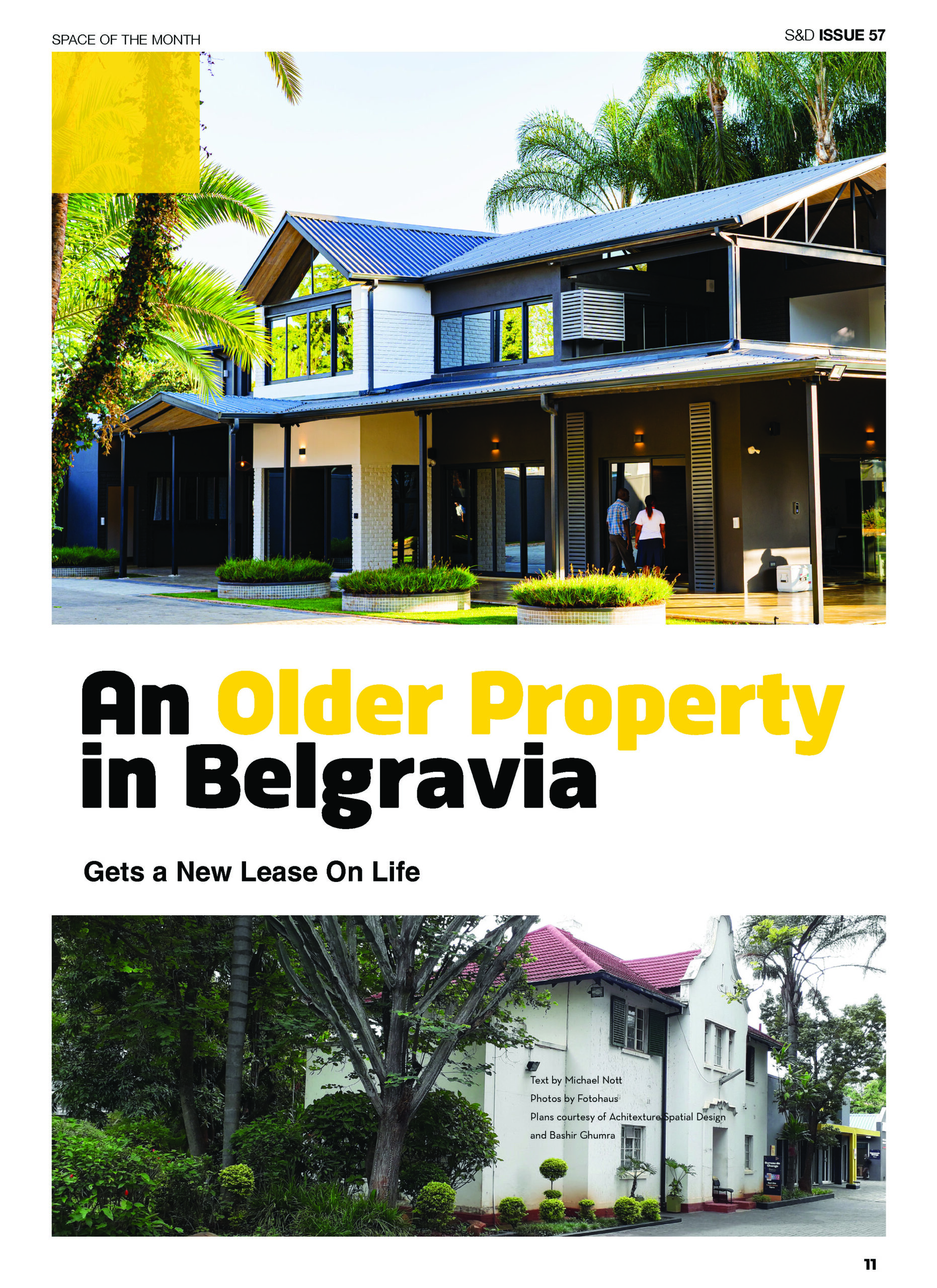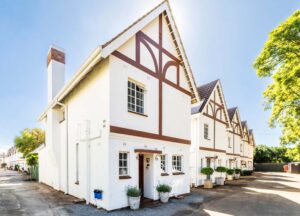Text by Michael Nott, Photos by Fotohaus, Plans courtesy of Achitexture Spatial Design and Bashir Ghumra
The property at 9 Phillips Avenue had been derelict and neglected for several years when it was acquired by Mistras Properties in 2015. It was an older double-storey residence, typical of the Belgravia area, with an impressive Dutch gable at the front facing on to Sam Nujoma Street (Second Street). Although it’s in a prime position it was badly in need of some attention to bring the grand old home back to life. There was the main house as well as extensive other structures on the property set in fairly generous grounds with a well-established garden with palms and other established trees. On one side there was a big double garage with a workshop and storeroom as well as a row of accommodations for domestic workers – although all the structures were quite run down.
The first stage of the renovations started in 2014, converting and extending the old garage space and the domestic accommodation into offices. The two-car garage and workshop became the Harare ticketing office for Fastjet. The exterior walls of the garage, workshop, and storeroom were retained but all the interior walls were removed to open up the space. The wall height was raised to create a higher ceiling and a new pitched Chromadek roof was installed. There’s a small parapet wall across the top of the structure so the roof is hidden. The parapet wall also connects the new office space to the original house. In front large aluminium and glass doors were fitted to allow light into the interior and provide easy access for customers. As the glass frontage is west-facing a small portico, painted in Fastjet’s signature yellow, shelters the interior from the afternoon sun.
Inside a new ceiling and new floor tiles were fitted. The front open section has white tiles and silver aluminium seating and, of course, Fastjet’s signature yellow wall. There’s a small step up to the long counter which runs the full width of the space. The raised stepped-up platform has black tiles to make the step very obvious and to add a bit of interest to the interior. The stepped floor was part of the existing structure. The interior was specifically designed to provide a quick turnaround time for customers so there aren’t stuffy booths to sit down and discuss complex itineraries – most of the routes are simple point-to-point tickets.
Behind the counter, the original existing space has been extended slightly to accommodate offices, ablutions, and a small staff kitchenette. In front of the ticketing office, there’s a paved parking area for customers and a palisade fence onto Second Street. Large, bright signage makes the offices easily visible from the street. A portion of the old garden has been kept with elegant, tall palm trees that provide welcome shade from the afternoon sun. At the end of the paved area is a remarkable piece of artwork – a handmade mural set onto the boundary wall with scenes depicting some of Fastjet’s past and current destinations – Mozambique, Tanzania, South Africa, Zambia, and Zimbabwe. The mosaic was made from thousands of pieces of ceramic tile, each hand-cut and carefully placed. It was created by Lee Sanderson’s team from Burnt Earth and took almost two years to complete!
At the same time as the renovations for Fastjet were done the domestic quarters were renovated and extended to create new offices for TAAG Angola Airlines and SVS Visa Services. Again the roof was raised, new floors
and ceilings fitted and new aluminium and glass fronts installed. Work on the renovations and extensions started in 2014 and the Fastjet office officially opened in 2016.
The renovations were designed by Bashir Ghumra in conjunction with input from Fastjet’s commercial team.
In the meantime, the adjoining original house stood empty and neglected (and a little sad) for a number of years, until attention was focused on updating the place in 2021. It has now become the sleek and sophisticated head office for a national retail company.
The Operations Manager for the retail company, consulted with local architect Bruce Rowlands and his assistant Garikayi Mushambi from Architexture Spatial Design, to come up with some solutions. The renovations needed to maintain some of the historical character of the house, as well as being practical and attractive inside and out.
The answer was to turn the house around so that the main entrance would now be on the east side opposite the original front facade which previously faced onto Second Street. The new offices would have their own private driveway access from Phillips Avenue, totally distinct from the Fastjet entrance. At the old front – now the back – the charming Dutch gable would be retained, as well as the three windows below it, to preserve the historic personality of the house. The old front door would be closed in and replaced by a single fitted glass pane to allow light into the interior.
The back of the house had at some stage been renovated, rather unsympathetically, with modern aluminium doors on either side of the original bay window/back door. The bay window was removed and a new front entrance was created by squaring off the space, bringing the main entrance forward and creating a portico above it. All the old windows on the east side were rationalised and enlarged and new aluminium frames fitted, as well as folding aluminium doors leading to the boardroom. On the west side, openings were kept quite small to shelter the interior from the afternoon sun and help deaden the traffic noise from the busy street. The glazing is sound-absorbing and sun-tinted. Aluminium work was supplied by Pesid Designs.
A wrap-around verandah was added on three sides and the verandah floor slab extended. The verandah provides an outdoor seating area adjacent to the boardroom as well allowing access to the boardroom and kitchen without the need for interior passageways. Graham Westhoff from Shepperton Investments provided the tongue and groove ceiling on the verandah as well as most of the interior finishes. The tiled roof was replaced with a Chromadek roof that follows the pitch of the original structure and also ties in with the verandah roof.
On the ground floor, there’s the main entrance and reception area with large, open-plan offices on either side. The offices can each accommodate six workstations and both have big windows for natural light and air circulation. Cemcrete floors in the offices provide a clean, modern, low-maintenance finish. The boardroom space to the right of the entrance was extended, partly to accommodate the upstairs balcony Behind the reception area, in a separate vestibule, is the staircase leading up to the first floor. The staircase is still in its original position although it has new treads and risers and a new steel and glass balustrade – also supplied by Pesid Designs. A striking and very modern chandelier hangs above the stairwell giving a very clean, contemporary look to the old space. At the top of the stairs is a small seating area with a round table where staff and visitors can have an informal meeting and enjoy a coffee from the coffee bar. The kitchenette/coffee bar was installed by Kitchen Krazy.
To the left of the upstairs foyer is the main office which has its own fully fitted, private bathroom. It has a generous balcony, sitting directly above the boardroom, overlooking the garden and there’s even an outdoor gym area. There’s surprisingly very little traffic noise and the extensive view of the garden provides a calm and relaxing working space.
To the right of the foyer is the office of the Operations Manager, a second office, a restroom, and a storeroom. Most of the artwork on the first floor is from the First Floor Gallery.
Spacework assisted with the initial planning of the electrical layout, the interior space layout, and the selection of the furniture and finishes to help create a cohesive, comfortable, and sophisticated overall look and feel.
The garden at the back of the original house had been very neglected but it’s now an important part of the overall design. Graham Williams and Associates have created a beautiful garden in a fairly constrained space as well as managing to include a generous paved driveway, parking area, and a paved path to the main entrance. A rectangular, raised water feature centres the garden and echoes the rather formal, geometric shape of the house. He’s also used clever planting options to help screen the garden from the Fastjet driveway, so it’s now a tranquil and relaxing space that makes an impressive entrance for visitors.
The whole complex has both council and borehole water and there’s an extensive solar power system, installed by Myla Solutions, to ensure an uninterrupted power supply
It’s great to see that an elegant old house and the outbuildings have been respectfully renovated and updated and given a new lease on life. So often developers tend to view older structures as having little intrinsic value and the house and garden are cleared to make way for new, sometimes soulless, buildings that will most likely look outdated in a few years’ time.
Read our magazine here




 Text by Michael Nott, Photos by
Text by Michael Nott, Photos by 




